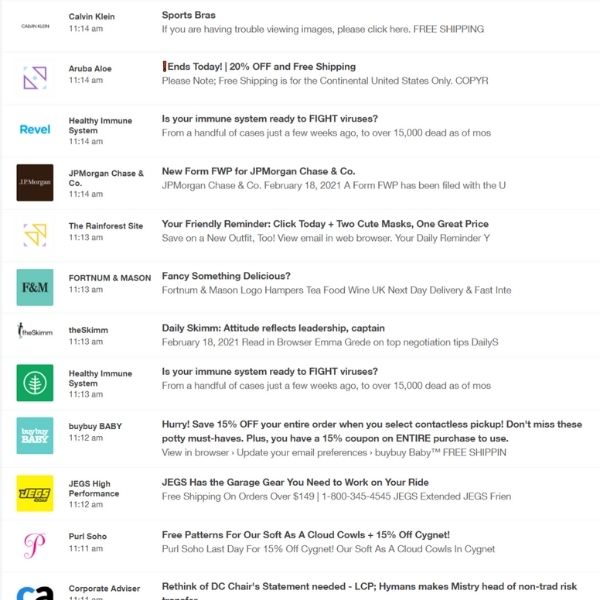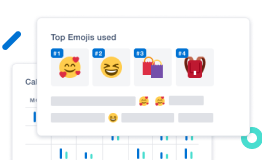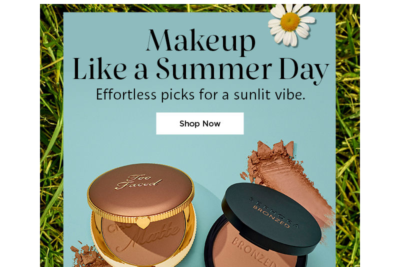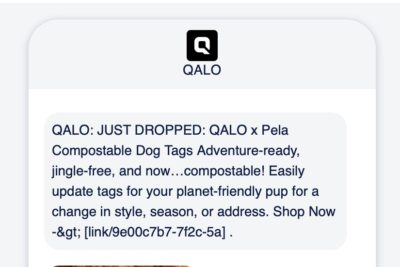Why is a great subject line important?
According to SuperOffice, 33% of recipients decide whether they’ll open your email based on your subject line alone.
At the same time, 69% of people said they report emails as spam if the subject line appears spammy.
This means you need to craft the best email subject lines for the highest chance of your emails being opened.
At the same time, your subject lines should reflect the content of your email so that readers aren’t confused or disappointed when they read an email that has nothing to do with the subject line.
If you’re stumped on what type of subject line to test next, check what your competitors are doing. Look at brands in your industry that target the same customers to get an idea of what resonates with that audience.
See the subject lines of your competitors and other top brands when you sign up for MailCharts. We track emails for top ecommerce brands to help inspire your next email campaign. Discover 1000s of subject line examples in our database.
The best email subject lines for ecommerce: styles
When it comes to writing the best subject lines for your audience, there are only two true rules to follow:
- pick a style.
- test, test, test.
While not writing your subject lines in all caps and keeping them relatively short are things that are generally accepted as best practices, the types of subject lines that work best for your audience might not work well for another and thus testing is crucial.
To help you get started, we’ve compiled a list of subject line styles with examples. Most of these styles aim to provoke a certain emotion within the recipient.
Further down this post, we’ll go into some great ecommerce subject line examples from brands in the MailCharts database.
Create fear of missing out
People hate missing out, whether it’s on a good deal, a limited edition, or an event. Playing to that fear in your subject line will increase the chances of them clicking it. After all, they don’t want to miss out.
There are three main ways you can generate a fear of missing out:
1. Through urgency
When using urgency, you’re making something available for a limited time only. This could be discounts, free shipping, or a buy-one-get-one offer.
Examples of urgency subject lines from brands we’re tracking here at MailCharts are:



2. Through scarcity
When using scarcity, you’re making it clear that your offer has limited availability. Once it’s gone, it’s gone. Oftentimes, creating scarcity also creates a sense of exclusivity. You only need to check the asking price for limited edition Nike sneakers on marketplaces to know that’s true.
Here are some examples of scarcity subject lines from our database:


![]()
3. Through social proof
Adding social proof isn’t often mentioned as a way to create a fear of missing out, but think of it: if you’re a fan of Billie Eilish or DeMar DeRozan, wouldn’t you want to wander around the city in the same outfit or shoot hoops in the same shorts as them?
Creating that opportunity for your customers means you’re at the same time telling them: “If you don’t buy from us, you’re not in the same club as celebrity X, Y, or Z”.
Some subject lines that use social proof:


![]()
Generate curiosity
People are curious by nature. They don’t like not knowing the answer to something so all you need to do is tease them with your subject line and then – this is important – satisfy their curiosity once they’ve opened your email. If the content of your email doesn’t have anything to do with your subject line, recipients will be annoyed and they might not open the next email you send them.
A few ways you can generate curiosity with your subject lines:
- ask a question.
- use a cliffhanger.
- mention something strange.
- hint to the content of the email.
Here are some examples:



Play to their vanity
Everyone wants to be liked, loved, and maybe even looked up to. As an ecommerce brand, you can respond to this need by promising to make the subscriber look better. Alternatively, you can also evoke a sense of shame.
But be careful if you go this route. You may have otherwise loyal customers who for some reason aren’t ready to buy right now and your shaming subject line might leave them feeling uncomfortable.



Address their problems
If you know your customers well, you also know what they’re struggling with and, ideally, you have the solution to some of their problems. Mention that solution directly in the subject line and then offer it in the body of your email.



Awaken greed
It’s so hard to pass up on a good deal. That’s why mentioning a discount or special offer in your subject line can work so well. Just make sure not to overdo it. If you have a sale every week, your subscribers will quickly learn it’s nothing special, and the incentive to open your emails will be gone.


![]()
Make them laugh
Humor is a dangerous tool. When used correctly, it can win you the hearts of your subscribers. Use it inappropriately, however, and it may cost you a lot of customers. That being said, humor can be a great way to establish a clear brand voice and attract like-minded customers.
If being funny isn’t already part of your branding, thread carefully and start with some safe jokes to see how people respond before potentially moving on to the more risky ones.
Here are some funny subject lines that work well:



Get personal
We’ve talked before about how important personalization is in email marketing, but you can do more than include a subscriber’s name. Why not include their location or tie their interests back to one of your products?
Getting personal is also a matter of tone of voice. It’s about talking to your subscriber like you would to a friend, keeping your subject line conversational and casual.
Here are a few examples:



Create controversy
Nothing like something controversial to make people click! However, this tactic only works if you actually have something controversial or shocking to say. Just like when you’re creating curiosity with your subject line, the body of your email needs to deliver on your promise not to leave the reader disappointed.
You also want to use this tactic sparingly unless you want your brand to seem like the tabloid of your industry.



Be purely informational
Sometimes, people just want to know what they’re getting. They’re having a busy day and they don’t want to waste energy trying to decide whether they should read your email or not. Maybe they’re waiting for an order confirmation or they want to check whether their favorite brand has something new going on during their lunch break.
There are plenty of cases where it pays off to let your subject line say exactly what your email is about.



Examples of great ecommerce subject lines for email
Welcome series subject lines
When writing welcome email subject lines, it’s important to take into account that the day the recipient signed up for your list might have been the first day they heard of you. In fact, by the time they check their inbox and see your welcome email, they may have already forgotten about you.
That’s why the best welcome email subject lines are transparent ones, like this one from Touch Of Class:

The subject line reminds the subscriber exactly what they signed up for:
- the list of Touch Of Class
- that sends out tips and products related to window solutions for the subscriber’s home.
Sign up for MailCharts to see more subject lines from Touch of Class.
Abandoned cart subject lines
The best abandoned cart subject lines make customers wonder why they ever abandoned their cart in the first place and rush back to check out. But to achieve that effect, your abandoned cart email subject lines need to be spot on.
Too soft, and the recipient may not even open your email. Too pushy, and you risk an unsubscribe.

Vintage Tub & Bath uses a great abandoned cart email subject line here. They add a sense of urgency by hinting that the items in the recipient’s cart might get sold out and on top of that, they’re reminding them that these items are their finds.
The shopper might have spent a lot of time selecting these. It would be a shame if the items would sell out and they’d need to go through the whole search process again.
Vintage Tub has more great email subject lines. You can see all of them when you sign up for MailCharts.
Purchase confirmation subject lines
As transactional emails that (hopefully) go out all the time, it’s easiest to have fixed formulas for your purchase confirmation subject lines. Of course, you’ll need to test these to see which formula works best, but best practice is to confirm your customer’s order straight within the subject line.
When someone just spent their money with you, they want to be sure everything went alright. A quick glance at your email in their inbox should tell them all they need to know.

This subject line from Stance is a start, but it’s still pretty unclear. After all, nobody remembers their order number or even looks at it before closing your webshop.

This order confirmation subject line from Etsy is better. It confirms that the order confirmation is from Etsy and even reminds the recipient which Etsy seller they bought from.
Sales subject lines
If you’re doing a sale, you’ll want to make that clear in your subject line.

Nine West leads with an hourglass counting down the time followed immediately by the huge 70% off on their boots. They then emphasize the sense of urgency they already created by explicitly mentioning the sale ends in just a few hours.
If the subscriber is in any way interested in getting a pair of new boots, this subject line will surely make them click.
![]()
West49 also clearly mentions their discount in the subject line of this sales email but they lead with a benefit or problem-solving solution for the recipient: they’re offering something to keep the subscriber warm in winter.
Product review subject lines
Getting positive product reviews is crucial to generate social proof for your brand. It’s also hard to do. People don’t need a lot to complain about something they’re not happy with but why would they go through the effort of leaving a review when all is well? They just want to go on using their product.
Because you can’t rely on them going to a review site or sending you a review themselves, you need to ask for it, and the best way to do that is via email.

This product review subject line by Build With Ferguson is excellent. It leaves no doubt as to what this email is about and reassures the recipient that answering the survey will only take one minute. If you’ve had a positive experience with their brand, a minute of your time is not too much to ask.

Bokksu takes a different approach and offers their customers Bokksu in exchange for a review. This incentive works especially well with loyal customers who already have some points and are saving to redeem them for something yummy from this candy subscription service.
You can see more smart subject lines from Bokksu in our MailCharts database.
Winback subject lines
If you’ve already lost or are on the verge of losing a customer, you want to make sure they read your convincing plea to make them stay (and buy again).

The Farmer’s Dog has a clever way of approaching customers who canceled their subscription. They don’t mention reactivating in the subject line but instead ask whether the recipient’s dog has enough food.
This subject line uses personalization (The Farmer’s Dog knows the name of their customer’s dog) while communicating care in a very conversational way, as if they’re talking to a friend.
They keep up this format with a short plain text email that makes it easy for the recipient to click the one present CTA or to reply.
Does Dexter have enough food?
Give Your Ecommerce Email Subject Lines The Time They Deserve
It all begins with a click. If subscribers don’t open your emails, you won’t woo, dazzle, or delight them. You won’t be able to share your message or create a connection, and you most certainly won’t be able to sell to them.
That’s why crafting great email subject lines is crucial.
This article contains plenty of tips and inspiration to start testing, but if you need more, sign up for MailCharts. Our database holds 1000s of email subject line examples from top ecommerce brands to help inspire your next email campaign.





